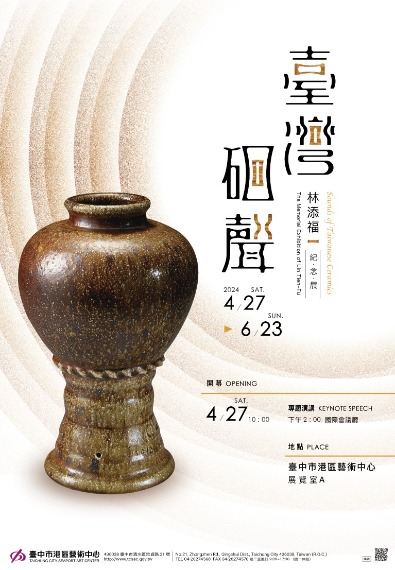The Sound of Taiwanese Ceramics -Memorial Exhibition of Master Potter Lin Tien-fu
美術工藝 Artistic Crafts
1982-1993「恒發陶瓷廠」歇業後,他決定留在自己的陶廠,守護這個自己一塊磚一塊磚砌起的蛇窯;不再為了賺錢做陶、不再為了生活奔波流浪,林添福對陶的心願,十分素樸,他想要把心目中「水」的陶器做出來。從一本故宮圖錄,開始從中擷取一些靈感,比方說模仿商周青銅器上的饕餮紋來做浮雕裝飾,或製作一些浮雕花鳥、動物賞瓶這類純供欣賞的器型,來為陶器賦予藝術價值。他也試著將傳統的日用陶放大成觀賞陶,供懷舊人士欣賞,期盼傳統日用陶器型的美感,有一天能再受到重視。這些陶器不只呈現了他畢生的技藝,也承載了他傳承與開創台灣陶藝文化的使命。
為了挑戰各種不同的形器,有時一個月只能刻一只,但用蛇窯燒又容易變形,這時成品只能當瑕疵品便宜賣,常常一只才賣一千塊錢。這樣的收入和他當師傅所賺的錢,實在無法相比。但不經營陶廠不請工人,釣魚種菜過日子反而沒有壓力,不必去管外界的凡塵俗事,這才得以真正解脫,心無旁鶩自在做陶。日子就在他認真創作、閒來釣魚中,靜靜淌過,這十年可以說是林添福轉型工藝美術的巔峰時期,正值壯年的他磨練半世紀的工藝已經到了爐火純青的地步,想到什麼就能做什麼,信手拈來,揮灑自如。然而,理想與現實總有扞格,生活清苦,好在兒子林瑞華時不時到其他的陶廠打工,當燒窯師傅和酒甕師傅,賺點錢貼補家用並購置了一座瓦斯窯。
有了瓦斯窯後,父子倆合力製陶,由林瑞華協助燒窯,林添福如虎添翼長才進一步得到發揮,當時臺灣流行喝老人茶,宜興壺當道,他開始研發茶桌椅組,試了三個月終於試燒成功。陶桌椅組成為主力產品,便有朋友鼓吹「你會做這麼大的陶桌,應該也會做茶壺!順便幫我做幾只茶壺吧!」為此他開始研究起茶壺的製作,一開始他的茶壺因為跟時下流行的宜興茶壺形式不同,一再受到買家的質疑,但林添福堅信「實用之美」。他認為宜興壺的造型不好用,堅持自己的造型,久而久之,使用過其茶壺的顧客都愛不釋手,都說不但好用、耐用,還很耐看、物美價廉,一出窯就售罄。這段時間林添福不但創作量豐富,且風格寬廣,長景瓶、大型香爐、蟠龍大盤等,都是這個時期的代表作。作品受到歡迎,他也很開心,總是笑得燦爛,在他的笑容中所醞含的更多是被認同與欣賞的滿足,而這種滿足感正是他一心為陶最大的報償。
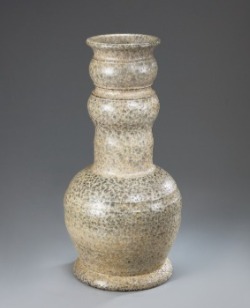
貝殼釉賞瓶
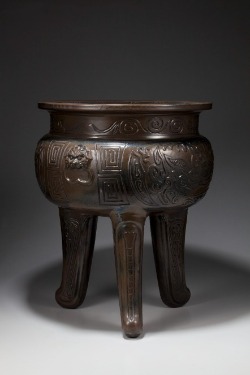
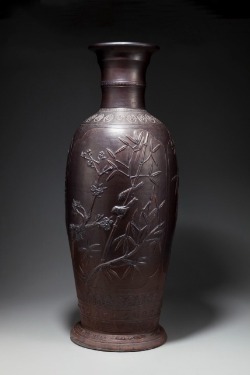
梅竹浮雕瓶
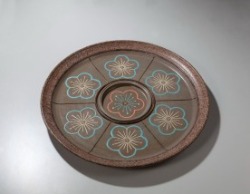
Seven Plums Plate
66×66×6.5 cm
1990's
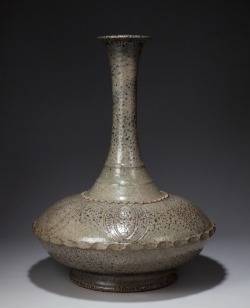
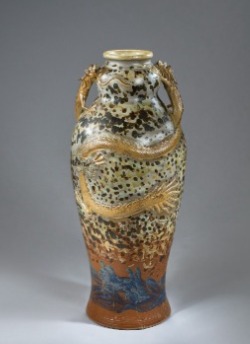
彩色雙龍吉祥瓶
Colorful Double Dragon Auspicious Vase
43×43×100 cm
1990's
After the closure of the "Heng Fa Ceramics Factory," Lin Tien-fu decided to stay at his own pottery, guarding the dragon kiln he built brick by brick. He no longer made pottery for money or had to wander for a living. Lin Tien-fu had a simple wish for pottery - He wanted to create beautiful pottery that matched his vision. He drew inspiration from a National Palace Museum catalog, incorporating designs like Taotie patterns from Shang and Zhou dynasty bronze ware into relief decorations.
To challenge various forms and shapes, he sometimes spent a month on a single piece. However, firing in the dragon kiln often caused deformities, and the finished products could only be sold as flawed items at lower prices, typically around a thousand dollars per piece. This income was incomparable to what he earned as a master craftsman. Despite not running a pottery business and not hiring workers, Lin Tien-fu found solace in fishing and gardening, free from worldly distractions, allowing him to truly focus on pottery. His days passed quietly, with diligent creation and leisurely fishing. This decade was Lin Tien-fu's peak period of artistic transformation. By his prime, he had honed his craft for half a century and could effortlessly materialize any idea that crossed his mind.However, dreams often clashed with reality.
Life was frugal, but fortunately, his son Lin Jui-hwa occasionally worked at other pottery workshops as a kiln master or jar maker, earning extra money to support the family and purchasing a gas-fired kiln.With the gas-fired kiln, father and son collaborated in pottery making. Lin Jui-hwa assisted in firing, and Lin Tien-fu's talents flourished further. At the time, Taiwan embraced the tradition of drinking tea, with Yixing teapots being highly sought-after. Lin Tien-fu started developing tea table and chair sets and succeeded after three months of trials. The ceramic table and chair sets became their flagship products, and friends encouraged him to make teapots, saying, "If you can make such large ceramic furniture, you should also make teapots!" This led him to delve into teapot making. Initially, his teapots faced skepticism due to their departure from the popular Yixing teapot style. However, Lin Tien-fu believed in the "beauty of practicality." He considered Yixing teapots impractical and stuck to his unique designs. Over time, customers who used his teapots became ardent fans, praising them for their functionality, durability, and affordability. His teapots sold out as soon as they were fired.
During this period, Lin Tien-fu's creative output was prolific and diverse, with notable pieces like long-necked vases, large censers, and dragon-shaped platters. As his works gained popularity, he remained cheerful, always wearing a radiant smile. Behind that smile lay a deep sense of fulfillment from recognition and appreciation, which he considered the greatest reward for his dedication to pottery.
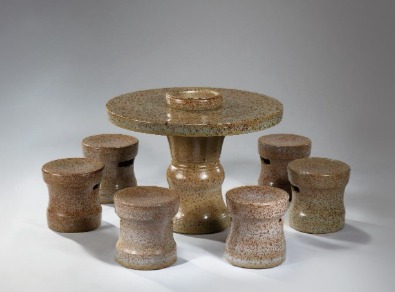
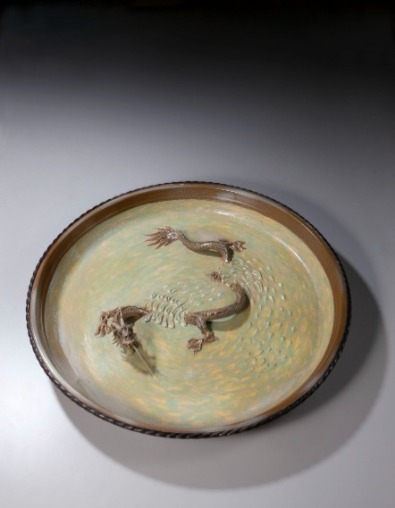
The Sound of Taiwanese Ceramics -Memorial Exhibition of Master Potter Lin Tien-fu
|展覽日期:2024/4/27 (六) - 6/23 (日)
|展覽時間:9:00-17:30(週一休館)
|展覽地點:台中港區藝術中心 展覽室A(台中市清水區忠貞路21號)
|開幕:2024/4/27 (六) 10:00
|專題講座:2024/4/27 (六) 14:00 3F國際會議廳
- Exhibition Dates: April 27, 2024 (Saturday)
- June 23, 2024 (Sunday)
- Exhibition Hours: 9:00 AM - 5:30 PM (Closed on Mondays)
- Exhibition Venue: Exhibition Room A, Taichung Port District Arts Center (No. 21 Zhongzhen Road, Qingshui District, Taichung City)
- Opening Ceremony: 4/27 10:00 AM
- Special Lecture: 4/27 2:00 PM in the 3rd Floor International Conference Hall
